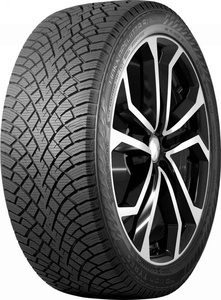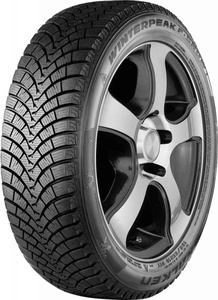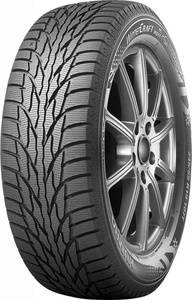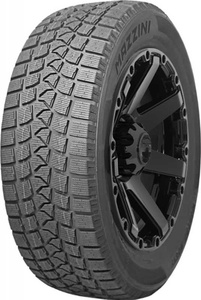Suchformular für Fahrzeugmodell, Reifengröße bzw. Felgen Wählen Sie unten eine Registerkarte aus, um Radangaben für Ihr Fahrzeug zu erhalten oder Fahrzeuge zu finden, die Ihren Kriterien entsprechen.
Vi Bilägare 2022: SUV Studdless Winter Tire Test R18

A new Nokian model raises the bar for ice traction, and a tire from the unrenowned Chinese brand Mazzini demonstrates what trying to save on safety can be fraught with.
List of models tested:- Bridgestone Blizzak DM-V3
- Continental VikingContact 7
- Falken Winterpeak F-Snow 1
- Goodyear UltraGrip Ice 2
- Kumho WinterCraft SUV ice WS51
- Mazzini Snow Leopard LX
- Michelin X–Ice Snow SUV
- Nokian Hakkapeliitta R5 SUV
The Swedish experts from the Vi Bilägare magazine tested friction winter tires in size 235/55 R18, designed for SUVs and crossovers; among other tires, the test involved the 2022 newcomer — Nokian Hakkapeliitta R5 SUV. Besides the Nokian model, the test also involved tires from Bridgestone, Continental, Falken, Goodyear, Kumho, and Michelin; for comparison, the experts also included in the test pool a tire from the private brand Mazzini, owned by the Chinese company Best Choice International, which also offers tires under the brands of Delmax, Autogreen, and Gowind.
According to experts, friction tires, designed for heavy and tall SUVs, are characterized not just by reinforced construction, but sometimes by stiffer tread compounds, which, of course, affects their behavior. For example, on snow and ice tires of this type are usually slower to recover grip after losing it than the regular studded tires, and, in the case of SUVs, the sliding distance increases dramatically. The vehicle’s extra weight and the stiff compound make it difficult to regain grip after losing it, and this also applies to cars with all-wheel drive.
The test car was a Volvo XC40, and during the test conducted in mid-winter in the vicinity of Vistheden not far away from Älvsbyn, the use of all-wheel drive led to a huge difference in the ice acceleration results. The best tires «found» grip instantaneously, and the worst ones were not even saved by the adaptive all-wheel drive system. Eventually, the experts decided to disable this feature, which ultimately resulted in a larger scatter of measurements for one and the same tire, because the electronic system would distribute power in different ways, which meant that the tests were conducted in vain, and the experts had to repeat them in the Arctic Falls indoor test facility near Piteå, Sweden. The company rented two front-wheel drive XC40’s, and in the controlled environment of a 400 meter long tunnel the experts finally conducted the ice and snow acceleration and braking tests with the required reproducibility of the results. After that, they had to conduct the tarmac tests, for which in the beginning of May the experts headed to a proving ground near Tampere, Finland.
Ice
First place in the ice acceleration test was scored by the new Nokian model, four other tires — Michelin, Falken, Goodyear, and Continental — also showing good results. Bridgestone and Kumho were a bit behind, and the worst ice acceleration was demonstrated by the Mazzini tire.
Ice Acceleration
- Nokian
- Michelin
- Falken
- Continental
- Goodyear
- Kumho
- Bridgestone
- Mazzini
Info! Acceleration time from 5 to 15 km/h, sec.
The best ice braking performance was demonstrated by the Nokian and Michelin models, while the Mazzini again had issues — its stopping distance was almost twice as long as that of the leaders. Poor performance in this discipline was also demonstrated by the Kumho tire.
Ice Braking
- Nokian
- Michelin
- Goodyear
- Continental
- Falken
- Bridgestone
- Kumho
- Mazzini
Info! Braking in the range of 25–5 km/h, m.
On the ice course, the best lap time was secured by the Nokian model, which ensured the best lateral stability, and behaved in a predictable way when pushed to the traction limit. It was followed by the Continental and Falken, which confidently maintained grip under loads, while the Kumho tire could bring an unpleasant surprise, suddenly going into a skid; the worst performance in this discipline again being demonstrated by the Mazzini model.
Ice Handling
- Nokian
- Continental
- Falken
- Michelin
- Goodyear
- Bridgestone
- Kumho
- Mazzini
Info! Lap time, sec.
Snow
Friction tires usually demonstrate virtually identical snow traction, and this was the case this time, the best being Michelin, followed by Falken and Nokian. The only tire with a relatively low result was the Kumho model.
Snow Acceleration
- Michelin
- Falken
- Nokian
- Goodyear
- Mazzini
- Continental
- Bridgestone
- Kumho
Info! Acceleration time from 5 to 25 km/h, sec.
The snow braking distances also differed insignificantly, first place in this discipline being scored by the Nokian model, while the Mazzini’s tread pattern with large tread blocks was definitely more effective on snow than on ice.
Snow Braking
- Nokian
- Mazzini
- Michelin
- Falken
- Bridgestone
- Goodyear
- Kumho
- Continental
Info! Braking in the range of 35–5 km/h, m.
In the snow handling test, just as on ice, the best performance was demonstrated by Nokian; also, easy handling performance on the traction limit was demonstrated by the Falken tire from the Japanese Sumitomo. At the same time, the Goodyear model was constantly toggling between understeer and oversteer, and the worst performance in this discipline was demonstrated by the Kumho tire that again turned out to be prone to sudden skidding.
Snow Handling
- Nokian
- Falken
- Bridgestone
- Goodyear
- Michelin
- Continental
- Kumho
- Mazzini
Info! Lap time, sec.
Wet
Only straight hydroplaning resistance was evaluated, and the VB experts noted that friction winter tires tend to demonstrate poor results in this particular discipline. As the test showed, the best tires to combat the hydroplaning effect were Kumho, Goodyear, and Mazzini, while the Continental also delivered enough grip, and the other tires had certain difficulties.
Straight Hydroplaning Resistance
- Kumho
- Goodyear
- Mazzini
- Continental
- Falken
- Michelin
- Bridgestone
- Nokian
Info! Float speed, km/h.
Tire technologists often have a hard time combining ice grip and wet traction, and thus it comes as no surprise that the Michelin and Nokian models ended up at the bottom of the tournament bracket in terms of wet braking performance, and the Mazzini tire surprisingly became one of the leaders. At the same time, however, first-placed was the Goodyear model, which, just as it did in the previous tests, again proved its status as being one of the most effective Scandinavian-type tires for rainy weather.
Wet Braking
- Goodyear
- Mazzini
- Kumho
- Falken
- Bridgestone
- Continental
- Nokian
- Michelin
Info! Braking in the range of 80–5 km/h, m.
The Goodyear model also surpassed the competition in the wet handling test. The Nokian and Continental models also scored high points, while driving on the Kumho tires, it will be more difficult to control the car because this model is prone to skidding on the rear axle. At the same time, the Bridgestone model performed even worse, and the VB experts noted that this model from the Japanese brand had the weakest lateral stability and was strongly prone to understeer.
Wet Handling
- Goodyear
- Continental
- Nokian
- Michelin
- Falken
- Mazzini
- Kumho
- Bridgestone
Info! Lap time, sec.
Dry
On dry pavement, the supple rubber compounds used in the production of friction tires negatively affect their performance, and, unlike in the wet tests, the results demonstrated by the tires, differed only slightly. The fastest to stop the car were Bridgestone and Falken, and the worst by this criterion was the Kumho model.
Dry Braking
- Bridgestone
- Falken
- Goodyear
- Continental
- Mazzini
- Michelin
- Nokian
- Kumho
Info! Braking in the range of 80–5 km/h, m.
In the dry handling test, the victory was scored by the Goodyear model that ensured precise handling response and the highest level of safety during the emergency lane switching exercise. The Michelin and Nokian models did not provide as accurate steering response, but they did behave in a safe and predictable way under loads. The Falken tire was less stable, and, in addition, it was prone to understeer. The worst performance in this respect was shown by the Mazzini tire, on which it is difficult to control the car during a sharp detour of an obstacle.
Dry Handling
- Goodyear
- Continental
- Kumho
- Michelin
- Nokian
- Bridgestone
- Falken
- Mazzini
Info! Subjective, points.
The VB experts also evaluated the tires’ environmental performance, measuring the fuel consumption by the Volkswagen Tiguan 2.0 TDI on an oval track at 70 km/h. The lowest rolling resistance was shown by the new Nokian model; the tires that significantly increased the fuel consumption by the vehicle were the Falken and Bridgestone. In Sweden, the difference between the best and worst tires will be equivalent to an additional cost of 1,280 Swedish Crowns (113 USD) per 10,000 km.
Environment
- Nokian
- Continental
- Goodyear
- Michelin
- Kumho
- Mazzini
- Falken
- Bridgestone
Info! Fuel consumption at 70 km/h, l/100km.
The cabin noise was measured, and the subjective evaluation significantly influenced the combined score. As the measurements showed, despite its rather rigid tread compound, the quietest tire was the Goodyear, while the new Nokian model, as the VB experts noted, solved the noise issues of the previous generation tires. At the same time, the Kumho tire was making an annoying monotonous noise, and the Mazzini model was distinctly humming already at 30 km/h, and the hum increased as the car was picking up speed.
Verdict
This year, there were few new models on the winter tire market, and, probably, the most significant premier was the release of the Nokian Hakkapeliiitta R5, which came to replace the Hakkapeliitta R3 model. The SUV version of this tire took part in independent tests for the first time, and it scored a rather confident victory thanks to very good ice and snow grip. According to the experts, the new Nokian model provided impressive lateral stability on the ice track and was the only tire that in such conditions retained good controllability even after losing grip.

The VB experts also noted that the R5 SUV tire was significantly quieter than the previous-generation model, and the annoying noise, which used to pop up at certain frequencies, disappeared. In addition, the handling precision on dry pavement became much better, and during the emergency lane switching maneuver the tire responds much quicker to the driver’s inputs, at the same time maintaining good stability. A cherry on top was the lowest rolling resistance on test, but it was not without issues, such as a long wet braking distance and poor hydroplaning resistance.
Second-placed was the Goodyear UltraGrip Ice 2 that will be a great option for those who drives chiefly on cleared roads in the wintertime. The Goodyear model was recognized to be the best on wet pavement due to high hydroplaning resistance, good lateral stability, and the shortest wet braking distance on test. In addition, the UGI2 demonstrated excellent dry handling performance, and was among the leaders in terms of noise comfort. Although friction tires with good tarmac performance often indulge in weaknesses on snow and ice, this time around the Goodyear tire proved that well-balanced performance is indeed possible: specifically, in winter conditions, the UGI2 had the shortest braking distance on test. At the same time, lateral stability could have been better — the grip could go relatively abruptly and without a warning.
Bronze was scored by the Continental VikingContact 7, a model that earlier won in a few VB tire tests in passenger car sizes. In order to adapt the tire to being fitted on heavy SUVs, Continental increased the stiffness of the tread compound, which slightly compromised ice and snow grip, and led to the fact that the slides were a bit longer than the experts anticipated. At the same time, its overall traction was still better than that of many of the rivals. The advantage of the given tire size is that the wider circumferential grooves improve hydroplaning resistance, and at the same time the VC7 ensures excellent dry handling response, including during an emergency detour of an obstacle. On the whole, this Continental model was not the absolute winner in any of the disciplines, but it demonstrated equally good results on all types of surfaces.
The fourth line of the tournament bracket was occupied by the Michelin X–Ice Snow SUV. According to the experts, while the passenger car version of the X–Ice Snow tire with its rather stiff tread compound ensures rather good stability on tarmac, yet is inferior to some competitors in winter conditions, the SUV version, due to a more rugged tread pattern, had some of the best scores on snow and ice. At the same time, for all intents and purposes, the Michelin tire technologists prioritized longitudinal traction, so valuable during acceleration and braking — but the tire’s lateral stability was not as great. It was also not without some obvious issues: the Michelin tire had clearly poor wet traction, which stopped it from getting to the winner’s pedestal.
In the VB test of studded tires, the Falken model was disqualified due to the fact that it was losing its studs prohibitively quickly, but the studless tire from this Japanese brand demonstrated a rather decent performance and secured the fifth line of the tournament bracket. The VB experts noted that, just as the studded tire F-Ice 1, the F-Snow 1 model features a supple rubber compound that improves ice and snow traction. At the same time, this supple construction is more flexible, which improves overall winter performance, boosting the rear traction and reducing the risk of skidding under loads. The soft compound also reduced the tire’s dry braking distance, but its downside is fuzzy steering response, and strong understeer during emergency maneuvers. By and large, this tire is a good option for those who in the wintertime often uses their car on unplowed snow- and ice-covered roads.
One line lower down the order was occupied by the Bridgestone Blizzak DM-V3 tire, whose advantages were a noiseless ride, short dry braking distance, and high lateral stability on snow. At the same time, this tire was inferior to its premium competitors in terms of lateral grip, and this is an important parameter for winter tires because it directly affects driving safety. In addition, despite the wide circumferential grooves, the tire’s hydroplaning resistance also left much to be desired, and the Bridgestone’s overall performance was more than modest.
The seventh line of the tournament bracket was occupied by the Kumho WinterCraft WS51, which, judging by its stiffest tread compound on test, was clearly engineered with a focus on tarmac performance, and which compromised its snow and ice performance. In the tests conducted on ice and snow tracks, the Kumho tire performed considerably worse under loads, and lost grip abruptly and without warning. At the same time, however, the tire demonstrated excellent hydroplaning resistance, it quickly stopped the car on wet pavement, and ensured excellent handling response at small steering angles. Unfortunately, the Kumho tire also was prone to quickly losing traction on both wet and dry pavement, particularly in corners on the wet track, and this tire also could not score a high position in the noise comfort ranking. Thus, loss of control under loads and relatively poor «winter» traction led to the fact that the Kumho tire scored the last-but-one place in the final standings.
The worst tire was expectedly pronounced to be the budget Mazzini Snow Leopard LX, one of the cheapest tires available on the Swedish market, which visually differs from the other participants of the test with a tread pattern with large blocks and groves. Such a design ensured good resistance to hydroplaning, as well as high snow grip, but only during acceleration and braking, whereas the Mazzini model was inferior to the competitors in terms of lateral stability, and significantly, too (but the tire at least informed about reaching the grip limit). On ice, the tire goes into a skid even at low speeds, and has a very long braking distance. On dry pavement, the dry handling response was better than one could expect, even though, as the VB experts noted, «the tire allows you to make a quick turn, but only in one direction, and when you try to steer the car back, strong understeer appears." The experts added that the tire was also characterized by loud noise and poor feedback through the steering wheel, and the last place in the final standings is more than justified.
1st place: Nokian / Hakkapeliitta R5 SUV
Nokian Hakkapeliitta R5 SUV
- This tire replaced Nokian / Hakkapeliitta R3 SUV
- Available Sizes in Line: 72
- Year Released: 2022
- Regions for sale: North America, Europe, Russia+

- Excellent ice grip
- Good performance on all types of surfaces
- Low rolling resistance
- Long braking distance on wet pavement
- Poor straight hydroplaning resistance
- Very good
2nd place: Goodyear / UltraGrip Ice 2
Goodyear UltraGrip Ice 2
- This tire replaced Goodyear / UltraGrip Ice+
- Available Sizes in Line: 49
- Year Released: 2014
- Regions for sale: Europe, Russia+

- Excellent wet performance (for a Scandinavian-type tire)
- Low noise emission
- Relatively low lateral stability on ice and snow
- Very good
3rd place: Continental / VikingContact 7
Continental VikingContact 7
- This tire replaced Continental / ContiVikingContact 6
- Available Sizes in Line: 102
- Year Released: 2018
- Regions for sale: USA+, Canada, Europe, Russia+, East Asia

- Strong traction and good handling response on all types of surfaces
- Increased noise emission
- Good
4th place: Michelin / X-Ice Snow SUV
Michelin X-Ice Snow SUV
- Available Sizes in Line: 38
- Year Released: 2020
- Regions for sale: USA+, Canada, Russia+, Japan

- Short braking distance on snow and ice
- Good stability and dry handling response
- Insufficient grip on wet pavement
- Poor hydroplaning resistance
- Good
5th place: Falken / Winterpeak F-Snow 1
Falken Winterpeak F-Snow 1
- Available Sizes in Line: 31
- Year Released: 2021
- Regions for sale: Europe

- Good grip and high level of driving safety on snow and ice
- Low noise emission
- Insufficient stability and poor handling response on tarmac
- High rolling resistance
- Good
6th place: Bridgestone / Blizzak DM-V3
Bridgestone Blizzak DM-V3
- This tire replaced Bridgestone / Blizzak DM-V2
- Available Sizes in Line: 65
- Year Released: 2019
- Regions for sale: Europe, Russia+, China, South Korea

- Short braking distance on dry pavement
- Good lateral stability on snow
- Low noise emission
- Poor lateral stability on wet pavement
- Low hydroplaning resistance
- High rolling resistance
- Good
7th place: Kumho / WinterCraft SUV Ice WS51
Kumho WinterCraft SUV Ice WS51
- Year Released: unknown
- Regions for sale: Europe

- Good hydroplaning resistance
- Short braking distance on wet pavement
- Good handling response on asphalt
- Weak traction on ice
- Poor handling performance on all types of surfaces
- Satisfactory
8th place: Mazzini / Snow Leopard LX
Mazzini Snow Leopard LX
- Year Released: unknown
- Regions for sale: Europe

- Good snow grip
- Short braking distance on wet pavement
- Excellent hydroplaning resistance
- Poor ice traction
- Poor stability on dry pavement
- Irritating noise

ADAC 2022: Winter Tire Test R16
The Continental tires net double in the ADAC tests. List of models tested: Bridgestone Blizzak LM005 Continental WinterContact TS 870 Cooper Weathermaster SA2+ Dunlop Winter Sport 5 ESA+Tecar Supergrip Pro Falken Eurowinter HS01 Goodyear UltraGrip Performance+ GT Radial WinterPro2 Kleber Krisalp HP3 Matador MP 93 Nordicca Michelin Alpin 6 Nokian WR Snowproof Sava Eskimo HP2…

Moottori 2022: Studless Winter Tire Test R16
The Finnish magazine decided to check whether Asian tire makers can offer really good tires for a Nordic winter. List of models tested: Continental VikingContact 7 Falken Winterpeak F-Snow 1 Federal Himalaya ICEO Goodyear UltraGrip Ice 2 Kumho WinterCraft ice Wi51 Michelin X–Ice Snow Nokian Hakkapeliitta R5 Toyo Observe GSi-6 HP…

Auto Motor und Sport 2022: Winter Tire Test R19
The German magazine conducted its next test of European tires, whose characteristics, as the experts noted, are gradually drifting away from the Nordic tires. List of models tested: Bridgestone Blizzak LM005 Continental WinterContact TS 870 P Cooper Discoverer Winter Falken Eurowinter HS01 Firestone Winterhawk 4 Michelin Pilot Alpin 5 Uniroyal WInterExpert Vredestein…

ADAC 2022: Winter Tire Test R15
The ADAC experts tested 16 winter tires, two of which ended up being rated as «Good», and two were not up to the set tasks, and received a «not recommended» stamp. List of models tested: Avon WT7 Snow Barum Polaris 5 BFGoodrich g-Force Winter 2 Bridgestone Blizzak LM005 Continental WinterContact TS 870…

Vi Bilägare 2022: SUV Studded Tire Test R18
One of the tires involved in the new Vi Bilägare test was shedding its studs so fast that it was disqualified. The tire maker admitted to the problem and offered the consumers a free replacement. List of models tested: Continental IceContact 3 Falken Winterpeak F-Ice 1 Goodyear UltraGrip Arctic 2 Maxxis…
